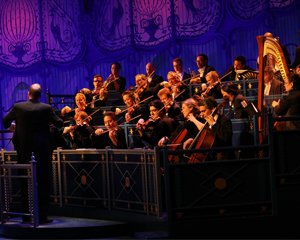As My Fair Lady edges into its final weeks, I’ve been asking myself: which key players in the production’s success have I overlooked? One of them is Marc Salzberg, who did the sound design. It is fitting that I say a few complimentary words about Salzberg and let him say a few words about what he does. He has earned the attention: after Junk, the production that preceded My Fair Lady in the Beaumont, Salzberg retired as the day-to-day production soundman at LCT, a job now done very capably by Adam Smolenski.
I began my conversation with Salzberg by asking: what does a sound designer do? He replied: “A sound designer is responsible for what everybody hears, how they hear it, and what it sounds like.” This work extends to many more people than the audience or the actors on the stage. The sound designer is also responsible for what all the people backstage are hearing. The stage manager, for example, has to hear the orchestra separately from how the singers hear the orchestra, and the people responsible for the lighting have to be able to talk to each other without bothering the stage manager. The back-and-forth backstage audio permutations are nearly endless. “I have to tailor the technical system to meet what everybody needs,” Salzberg said. “We can accomplish this now because of the capability brought to us by digital audio and video.”
Salzberg got his start in the analogue era. He grew up in the Boston area. His best friend’s father was a violinist with the Boston Symphony Orchestra, so, Salzberg said, “there was always music in my world.” He explained that “I fell into the world of sound design,” but there was a professional progression. “I went to Brandeis. I was a music major for three years, before switching over to theater.” One summer, a professional theater production came through the university – The Passion of Dracula, starring Jose Greco – and Salzberg got an offer to work on it, eventually running the show’s sound.
It was a bus-and-truck gig. There were, Salzberg said wryly, some “Noises Off kind of absurdities. We once got to a theater to find out they’d cancelled the performance without telling us. But we didn’t mind: we had the night off!”
Salzberg’s first show as sound person in LCT’s Newhouse was Six Degrees of Separation, in 1990, and his first in the Beaumont was Ivanov, in 1997. He’s worked on dozens of LCT shows doing the day-to-day sound mixing. For My Fair Lady, he’s done not the mixing but the design. I asked Salzberg about the challenges of doing sound in the Beaumont. His answer was very clear but would require a little too much space for me to explain technically in a blog posting. Suffice it to say that in a thrust space such as the Beaumont the actors tend to hear each other differently than they do in more traditional Broadway proscenia, where Salzberg has also worked.
Salzberg credits his friend and golfing buddy, the sound designer Scott Lehrer, for a breakthrough at the Beaumont. “When we did South Pacific, Scott came up with a system that I have used and expanded on. It uses digital delays that allow us to localize sound for the actor.”
Digital delays have also been useful in My Fair Lady. At the start of Act Two, Salzberg explained, “you’ve got musicians onstage for the ball scene. They finish the music and 30 seconds later, during ‘You Did It,’ it sounds as if those musicians are back in the orchestra pit but they’re not. That’s all due to the magic of technology,” Salzberg added: “I always tell people not to encourage their kids to go into the field of sound design because it’s a difficult life. But if it’s the life that fits you – if you find the magic – then there’s nothing else like it.”
Brendan Lemon is the editor of lemonwade.com
